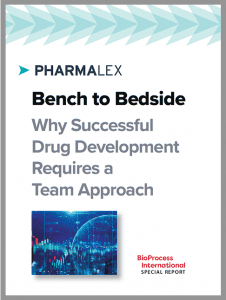Voices of Biotech
Podcast: MilliporeSigma says education vital to creating unbreakable chain for sustainability
MilliporeSigma discusses the importance of people, education, and the benefits of embracing discomfort to bolster sustainability efforts.
February 11, 2022
Sponsored by PharmaLex
 The process from drug development to market approval takes many years and requires both integration and orchestration of several activities based on deep scientific and commercial expertise. We tend to think of drug development as a sequential, phase-driven process during which a product is taken methodically from discovery through preclinical studies, clinical development, and ultimately commercial launch. In reality, development of new drugs is not linear; rather, it requires integrated coordination between collaborators from different functions and stakeholders — from a program’s outset — to help ensure success. Too often, the different activities involved in drug development are managed in functional siloes rather than through integration. This lack of integration and coordination can affect a development program adversely in several areas, from regulatory submissions to process development, outsourcing, and marketing.
The process from drug development to market approval takes many years and requires both integration and orchestration of several activities based on deep scientific and commercial expertise. We tend to think of drug development as a sequential, phase-driven process during which a product is taken methodically from discovery through preclinical studies, clinical development, and ultimately commercial launch. In reality, development of new drugs is not linear; rather, it requires integrated coordination between collaborators from different functions and stakeholders — from a program’s outset — to help ensure success. Too often, the different activities involved in drug development are managed in functional siloes rather than through integration. This lack of integration and coordination can affect a development program adversely in several areas, from regulatory submissions to process development, outsourcing, and marketing.
In this special report, Mark Lane of PharmaLex explains that an integrated product development strategy begins with a clearly defined destination. Of course, science and data influence the direction of a program, but the end goal must be kept in mind along with the necessary strategies to achieve it. Lane explains why the destination in integrated drug development is a target product profile (TPP) — and why developing a TPP is a team activity that requires input from different drug-development functions as well as from experts in regulatory and market intelligence who understand the competitive landscape.
Download the special report to learn more about how collaboration between a company’s scientific, clinical, regulatory, and commercial functions and partners helps to drive drug-development success.
You May Also Like